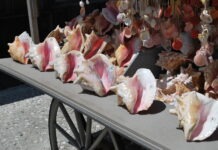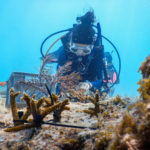
Mote Marine Laboratory and Aquarium has hosted its annual Staghorn Restoration Project with SCUBAnauts International and the Combat Wounded Veteran Challenge (CWVC) since 2010. Mote researchers research coral resilience and restoration. SCUBAnauts introduce teens to scientific SCUBA diving and leadership skills, enabling them to become tomorrow’s environmental and science leaders. The Combat Wounded Veteran Challenge helps injured and wounded veterans realize their potential for the benefit of all through education, rehabilitation, research and innovations.
Each year, the three organizations collaborate for a week of coral restoration and research collaboration. Mote’s top scientists train the students and veterans to tend to corals in Mote’s offshore coral nursery and outplant corals. SCUBAnauts and veterans gain valuable experience assisting with scientific research and find inspiration working with each other. “What we’re doing is bringing together the next generation of marine scientists and divers and combat veterans,” says Dr. Michael Crosby, Mote’s President and CEO. Over the week, divers from all three organizations conduct disease surveys, maintain corals in Mote’s nursery, and outplant corals onto local reefs.
The project is very special to Crosby, whose dad and two brothers served. “It’s beautiful to bring together all these different parties for coral restoration. It’s one of the most incredible things I’ve ever been a part of.” Crosby says. “Combat-wounded veterans are often looking for a new mission in life, and we want to give back to them. The youth will be the ones who inherit these reefs, and they need to understand how important they are. So, through this project, we all work together and contribute to bringing coral reefs back from the brink of functional disaster.”
After surfacing from a dive in Mote’s coral nursery, Lt. Thomas Faulkenberry, USCG, is all smiles. “For me, being in the water gets me rhythmically breathing. It’s very therapeutic and very healthy for me.”
Lt Col. Andrew Lourake, USAF, an above-knee amputee, agrees. “Diving is therapy for me in life. When I’m diving, my mind doesn’t notice its’ phantom pain.”
Both men have participated in the challenge for a few years and love the fact that they can do so much good through this unique partnership. They hug the kids who’ve also returned from previous summers like old friends, bragging about how great they are as people and how skilled they are as divers. Lourake expands on the added emotional benefit of the collaboration: “We want to protect this way of life and these kids. That’s why I went to war. It’s wonderful to have this chance to interact with them to restore the reef.”
A SCUBAnaut parent-chaperone explains the benefit of SCUBAnauts and this collaboration for her son Nolan. “Diving with a purpose has made all the difference for him. He’s learning to love science, and I can’t wait for him to take marine biology next year in school. He’s going to love it because of this experience.”
The student divers are AAUS trained, so they qualify as scientific divers and the data they collect can be used by research institutions like Mote. The students gain access to cutting-edge research, like the effort to understand stony coral tissue loss disease, the mysterious coral disease currently ravaging the Keys. SCUBAnaut Emma Paliotta, 15, of Sarasota describes her disease survey: “We found huge corals that took 100s of years to develop, all full of disease. It’s really disheartening that something that took so long to grow can degrade so fast.”
SCUBAnaut adult leader Shaian Blanc, 20, who has been part of the Mote-SCUBAnauts-CWVC collaboration for six years, provides a little more background. “First, it was climate change threatening the corals. Then it was Hurricane Irma. This year, it’s the coral disease. It’s saddening. We all need to do more to save our reefs.”
Crosby echoes this sentiment. He describes how Florida’s reefs create 72,000 jobs, increase biodiversity, support the culture of the Keys, and act as a natural barrier for the Keys. He recalls seeing 50-60% coral cover as a boy growing up in the Keys. Then, he accesses the current decline:
“We’re at 6% now and facing a terrible disease. We’re about to lose the rainforests of the sea.” Rather than become complacent or hopeless, Crosby, the scientists at Mote, the SCUBAnauts, and the CWVC collaborate every year to restore the reefs and to inspire each other. Crosby expresses why this collaboration gives him hope: “You don’t have to be a rocket scientist to know that the reefs are functionally extinct. But, you can be part of this story and turn it around. This project is special: We plant 500 corals in one day. One day, multiplied by 365 days a year, multiplied by 10 years. In 10 years, we can bring this back and increase coral cover.”
He concludes with a plea, “To save Earth, we must save the oceans first. Get connected and get involved in restoring these coral reefs.”































